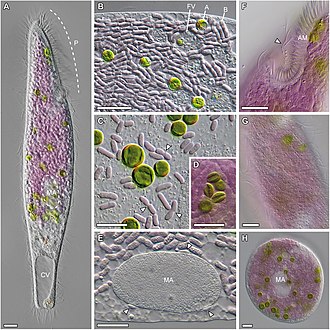Heterotrich
This articleneeds additional citations forverification.(October 2016) |
| Heterotrich | |
|---|---|

| |
| Stentor roeselii | |
| Scientific classification | |
| Domain: | Eukaryota |
| Clade: | Diaphoretickes |
| Clade: | SAR |
| Clade: | Alveolata |
| Phylum: | Ciliophora |
| Subphylum: | Postciliodesmatophora |
| Class: | Heterotrichea Stein1859 |
| Order: | Heterotrichida Stein1859 |
| Families | |
| |
Theheterotrichsare a class ofciliates.They typically have a prominent adoral zone ofmembranellescircling the mouth, used in locomotion and feeding, and shorterciliaon the rest of the body. Many species are highly contractile, and are typically compressed or conical in form.[1]These include some of the largestprotozoa,such asStentorandSpirostomum,as well as many brightly pigmented forms, such as certainBlepharisma.
Etymology
[edit]The termheterotrichderives from theancient Greekἕτερος(héteros), meaning "another, different", andθρίξ,τριχός(thríx, trikhós), meaning 'hair',[2][3]because of the contrast between the regular somatic ciliation and the one of the oral zone.[4]
Ultrastructure
[edit]A number of ultrastructural details characterize the group. The cilia on the body are indikinetids,in which either the anterior one or bothkinetosomesmay be ciliated, and which are associated with fibers composed of overlapping postciliarymicrotubules,calledpostciliodesmataand found only in this group and the closely relatedKaryorelictea.A series of oralpolykinetids,each containing two or three rows of kinetosomes, support the membranelles. These run from the left to the anterior of the mouth, and often spiral out of the oral cavity. The macronucleus is divided by external microtubules, whereas in theKaryorelicteait forms by differentiation of micronuclei, and in all other ciliates it is divided by internal microtubules.[5][4]
Pigmentation
[edit]Many species are highly pigmented, e.g. the blueStentor coeruleus.InBlepharisma,the red pigment is associated with light sensitivity. Species of blue-pigmentedEufolliculinaform extensive mats in the deep sea that have been called "blue mats".[6]
Systematics
[edit]
Early classification schemes byOtto Bütschli,Alfred Kahl,Emmanuel Fauré-Fremiet,andJohn O. Corlissclassified the heterotrichs as a subgroup ofspirotrichs.They included groups such asArmophorida,Odontostomatida,Licnophorida,Clevelandellida,andPlagiotomidawithin the Heterotrichea. However, more recent classification systems, which have incorporated information from molecular phylogenetics, place the above groups within the Intramacronucleata, because they are not closely related to the "core" heterotrichs at all.[4]Almost all of the "true" heterotrichs belong to a single order, Heterotrichida.
In the classification scheme of Lynn (2008), the order Heterotrichida contains the following nine families:[4]
- BlepharismidaeJankowski in Small & Lynn, 1985
- ChattonidiidaeVilleneuve-Brachon 1940
- ClimacostomidaeRepak, 1972
- CondylostomatidaeKahl in Doflein & Reichenow, 1929
- FolliculinidaeDons, 1914
- MaristentoridaeMiao, Simpson, Fu & Lobban 2005
- PeritromidaeStein, 1867
- SpirostomidaeStein, 1867
- StentoridaeCarus, 1863
Two new families were established in 2014 on the basis of molecular phylogenies:[5]
References
[edit]- ^Lobban, Christopher S.; Schefter, María (2016-01-01). "An Integrated Model of the Biology of the Marine SymbiosisMaristentor dinoferus".In Witzany, Guenther; Nowacki, Mariusz (eds.).Biocommunication of Ciliates.Springer International Publishing. pp. 305–326.doi:10.1007/978-3-319-32211-7_17.ISBN9783319322094.
- ^Bailly, Anatole (1981-01-01).Abrégé du dictionnaire grec français.Paris: Hachette.ISBN978-2010035289.OCLC461974285.
- ^Bailly, Anatole."Greek-french dictionary online".www.tabularium.be.Retrieved2017-01-24.
- ^abcdLynn, Denis H. (2008).The Ciliated Protozoa: Characterization, Classification, and Guide to the Literature. 3rd Edition.Springer. pp.129.ISBN978-1-4020-8238-2.
- ^abShazib, Shahed Uddin Ahmed; Vd’ačný, Peter; Kim, Ji Hye; Jang, Seok Won; Shin, Mann Kyoon (2014). "Phylogenetic relationships of the ciliate class Heterotrichea (Protista, Ciliophora, Postciliodesmatophora) inferred from multiple molecular markers and multifaceted analysis strategy".Molecular Phylogenetics and Evolution.78:118–135.doi:10.1016/j.ympev.2014.05.012.PMID24859684.
- ^"Sunday Protist -- Blue Mats of the deep sea: Folliculinopsis".skepticwonder.fieldofscience.com.Retrieved2017-07-25.
- ^NCBI:Pseudoblepharisma tenue(species)
- ^NCBI:Thiodictyon endosymbiont of Pseudoblepharisma tenue(species)
- ^Muñoz-Gómez, SA; Kreutz, M; Hess, S (June 2021)."A microbial eukaryote with a unique combination of purple bacteria and green algae as endosymbionts".Science Advances.7(24).Bibcode:2021SciA....7.4102M.doi:10.1126/sciadv.abg4102.PMC8195481.PMID34117067.
